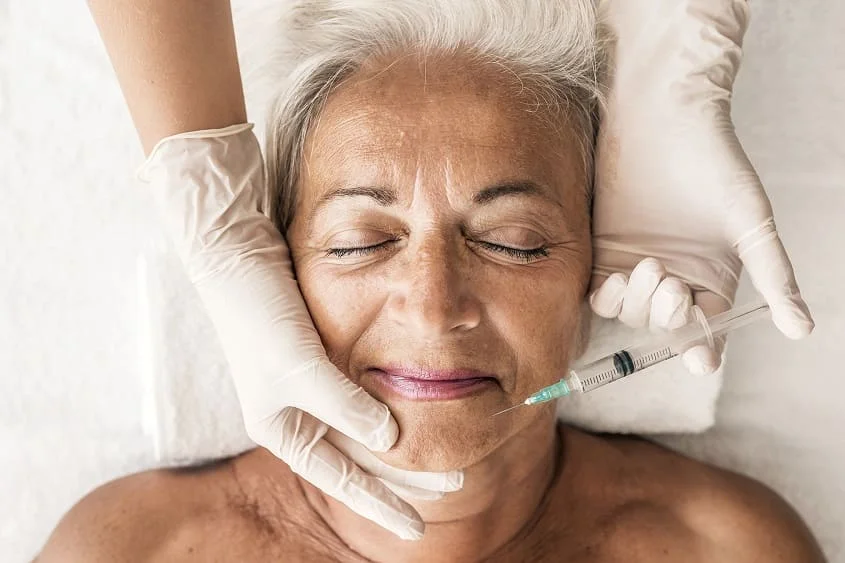Botox Injections: Pain, Bruising, and Recovery – What to Expect
- Updated on: Nov 25, 2024
- 4 min Read
- Published on Nov 14, 2023

Renowned for diminishing wrinkles and fine lines, Botox injections offer a quick and minimally invasive option to rejuvenate one’s appearance.
With the promise of smoother, more youthful skin without needing extensive recovery, individuals are drawn to Botox for its efficacy in turning back the hands of time.
The Basics of Botox Injections
Before we understand the process of managing pain and bruising in Botox, here are some basics you should know. This is how Botox works:
Mechanism of Action: Neurotransmission Interference
Botox injections operate by disrupting the normal process of neurotransmission. The neurotoxin inhibits the release of acetylcholine, a key neurotransmitter that facilitates communication between nerves and muscles.
This interference temporarily halts muscle contractions, addressing the root cause of wrinkles and fine lines.
Injection Procedure: Precision in Practice
The administration of Botox involves a meticulous process. Skilled healthcare professionals identify specific facial muscles responsible for undesirable wrinkles.
Fine needles inject precise amounts of Botox directly into these targeted muscles. The choice of injection sites is tailored to an individual’s facial anatomy and aesthetic goals.
Temporary Nature: Muscle Recovery
A distinctive feature of Botox treatment is its temporary impact on muscle function. While the neurotoxin induces temporary paralysis, the treated muscles gradually regain normal activity as the effects wear off.
How to Manage Pain and Bruising After Botox?
While Botox is generally considered safe, some individuals may experience pain and bruising at the injection site. Understanding and managing these side effects is crucial for a positive post-Botox experience.
Ice Packs
Applying ice packs to the treated area immediately after the procedure can help minimize pain and reduce the risk of bruising.
Use a clean cloth to wrap the ice pack and gently apply it to the injected site for 10-15 minutes. This helps constrict blood vessels, limiting blood flow and reducing swelling.
Avoid Touching the Area
Resist the temptation to touch or massage the treated area after receiving Botox injections. Touching can increase the likelihood of bruising as it may irritate the skin and disrupt the settling of the injected toxin.
Over-the-Counter Pain Relievers
Non-prescription pain relievers such as acetaminophen or ibuprofen can be effective in managing post-Botox discomfort.
However, it is advisable to consult with your healthcare provider before taking any medications, especially if you have underlying health conditions or are taking other medications.
Arnica Supplements
Arnica, a natural herb, is believed to have anti-inflammatory properties and may help reduce bruising. Some individuals opt for Arnica supplements or creams after Botox to promote faster healing and minimize discoloration.
Avoid Strenuous Activities
Engaging in strenuous activities immediately after receiving Botox injections can increase blood flow to the treated area. This can aggravate your bruising and discomfort.
Hence, avoiding vigorous exercise and activities that may strain the muscles for at least 24 hours after your Botox treatment is done is recommended.
Stay Hydrated
Proper hydration is essential for overall health and contributes to smoother recovery. Drinking an adequate amount of water helps flush toxins from the body. This will help you in reducing swelling and bruising.
Follow Your Provider’s Instructions
Adhering to the aftercare instructions provided by your Botox provider is crucial. They may advise you on specific care routines, including when to apply ice packs, what medications to avoid, and any other personalized recommendations based on your medical history.
Schedule a Follow-Up
If you experience persistent pain, severe bruising, or any unexpected side effects, promptly schedule a follow-up appointment with your Botox provider. They can assess your condition, address concerns, and provide additional guidance if necessary.
Recovery Tips and Expectations After Botox Treatment
Now, let us understand the realistic expectations you should keep for the recovery period after botox and the tips you can follow.
Gradual Onset of Results
Understand that the full effects of Botox may take several days to become noticeable. While some individuals experience immediate results, others may require patience as the neurotoxin gradually takes effect on the targeted muscles.
Temporary Side Effects
Prepare for temporary side effects such as redness, swelling, and bruising at the injection site. These side effects typically subside within a few days to a week.
Varied Duration of Results
The duration of Botox results varies from person to person. On average, the effects last three to four months. Factors such as individual metabolism, muscle strength, and the specific area treated can influence the longevity of the results.
Patience and Understanding
Exercise patience during the recovery period. Recognize that optimal results may not be immediate, and gradual improvements are normal. Avoid scrutinizing the treated area daily and give your body the time it needs to respond to the treatment.
Sun Protection
Protect your skin from direct sunlight, especially in the first few days after Botox. Sun exposure can increase the risk of bruising and negatively impact the treated area. If outdoor activities are unavoidable, use sunscreen and wear a hat to shield your skin.
Gentle Skincare Routine
Adopt a gentle skincare routine post-Botox. Avoid harsh products, exfoliation, or abrasive treatments that may irritate the skin. Opt for mild cleansers and moisturizers to maintain skin health without causing unnecessary stress to the treated area.
Communicate with Your Provider
Maintain open communication with your Botox provider throughout the recovery process. If you have concerns or questions or notice any unexpected changes, consult your healthcare professional promptly. They can offer guidance, reassurance, or adjustments if needed.
Plan Ahead for Special Events
If possible, schedule your Botox treatment well before any special events or occasions. This allows ample time for the effects to settle, reducing the likelihood of visible side effects during important gatherings.
Manage Stress
Stress can affect your overall well-being and may indirectly impact the results of Botox. Practice stress management techniques such as deep breathing, meditation, or engaging in activities that promote relaxation to support a smoother recovery.
Conclusion
That was everything we had to say to you about Botox injections. Knowing this will make you better prepared to start your Botox journey and understand the process. Once you do, the road to beautiful and youthful skin is as easy as possible.












